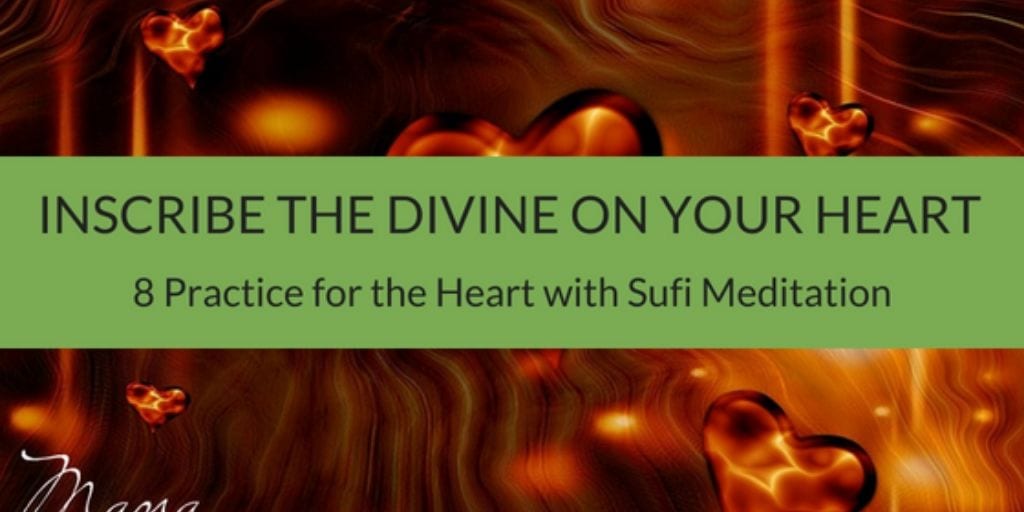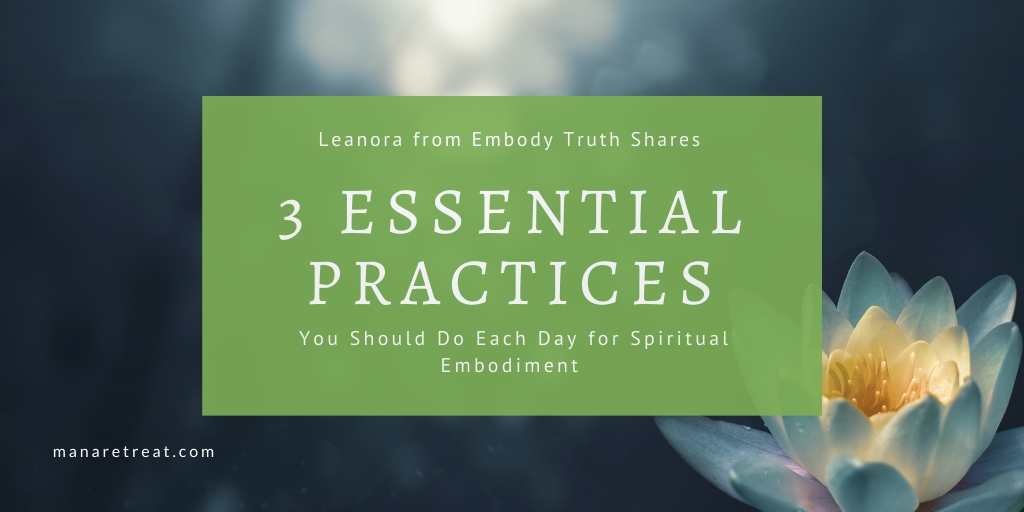Inscribe the Name of the Divine on Your Heart
Sufism is the esoteric path within Islam, where the goal is to purify oneself and achieve mystical union with the Supreme (named Allah in this tradition). The practitioners of Sufism are called Sufis, and they follow a variet of spiritual practice, many of which were influenced by the tradition of Yoga in India.
Unlike many of the other meditation techniques, Sufi meditation is spiritual by nature. There is no ‘secular version’ of these techniques, as the idea of God is part of their DNA. The core of all their practices is to remember God, fill the heart with God, and unite oneself with Him. So if you are atheist or agnostic, you probably won’t find these meaningful.
The journey of the Sufi is the journey of the lover returning to the arms of the Beloved, a journey of love in which we ‘die’ as egos so we can be one with Him. It’s the way of the heart. All of the practices are aimed at letting go of one’s ego, which is considered the biggest obstacle to realization.
The roots of Sufism date back to around 1,400 years ago, but they became near-extinct in the 20th century. There are different orders of Sufis, each emphasizing different exercises. In this article, I have drawn techniques from different schools.
Sufism is not a monastic path. The Sufi wayfarer lives in the inner world of the heart, as well as functioning responsibly in society.

1. The Heart of Sufi Meditation: Contemplation of God
Love flourishes in the heart in which glows the Name of God. The love of God is the fragrance that even a thousand wrappings cannot hold. Or like a river that cannot be stopped in its course. My Friend is in me, in my Friend am I–there is no separation between us. — Sultan Bahu
The core of Sufi meditation is to be conscious of the Divine at all times, until there is no longer a sense of separation between meditation, God, and daily life. This is called oneness (ekatmata)—that is, the complete merging with the Beloved and cessation of duality.
In Arabic, the word for meditation is muraqabah (also murakebe), and the literal meaning is to watch over, to wait or to protect. The essence of Sufi meditation is two-fold:
- Keep your attention focused on God, and awaken love in your heart so that you can merge with the Beloved;
- Constantly watch your mind so that no other thought except that of God enters the mind.
So there is watching over the mind, focusing the thoughts on God (remembrance of Him), and an awakening of love in the heart. This practice is done as a formal meditation, and also should be followed during all moments of one’s day. Irrelevant thoughts are considered harmful and one keeps a watch on the mind to make sure they don’t sprout.
Make everything in you an ear, each atom of your being, and you will hear at every moment what the Source is whispering to you, just to you and for you, without any need for my words or anyone else’s.— Rumi

The work of the lover is to be silent, waiting, always listening with the ‘inner ear of the heart’ for his call. Thus, ‘catching the divine hint’ is an important Sufi practice, in which we learn to be continually attentive to our Beloved in order to serve Him.
Almost all other forms of Sufi meditation are extensions of these basic principles.
2. Sufi Mantra Meditation
One of the most common ways to keep the remembrance of the Beloved, in Sufi orders, is by repeating His name. It’s a type of mantra meditation and similar to what is called contemplative prayer in Christian mysticism. It establishes an inner connection with the divine and results in bliss.
In Sufism, the name for mantra is Zikr (also Jikr or Dhikr), literally meaning remembrance. The essential aspect of this practice is the continual remembrance of God, typically by repeating one of these three words:
- Allah (God)
- Allah ho (God is)
- La illalahu (“God is God”)
- Any other of the 99 names of God
The goal is to inscribe the name of the Divine in your heart. For that, Sufis employ the methods of meditating on His name with the tongue (mantra repetition), gazing at the written word Allah, and writing Allah repeatedly on a paper. Eventually, the name grabs hold of you and illumines all of your being.
First you do the zikr and then the zikr does you. — Sufi saying

The emphasis is always to have the zikr going on all the time in your heart. But there is also time taken for the formal practice of sitting in silence and repeating the zikr. There is no particular posture for Sufi meditation.
Usually, this practice is synced with the breath. For instance, on the in-breath one says within one’s heart ‘Aal’ and on the out-breath one says ‘Laah’. Or it is done while focusing on the solar plexus or on the spiritual heart, which takes us to the next practice.
3. Heart Meditation
This practice, called Jikr-e-Sirr or Wakoof Kulbi (awareness of the heart), is a type of jikr (remembrance of God). It is one of the two central practices of the Naqshbandi Sufi.
For the Yogis, the spiritual heart (anahata chakra) is in the center of the chest, under the sternum bone. Some—like Ramana Maharshi and some Tantric texts—speak of the spiritual heart as being different from the heart chakra, and call it hridaya, saying it is on the right side of the chest. But according to the Sufis, the spiritual heart is at the same place where the physical heart is (on the left).
Here are the steps for this technique:
- Start by collecting your dispersed energies, bringing them from the outside world back into yourself. Still the mind and the senses so that you can directly experience the inner reality of the heart.
- Focus your attention intensely at the place where physical heart is located, until you forget all about yourself. This state of self-oblivion is considered the straight path to the Infinite.

The third step varies, according to the source and Sufi school. Here are some variations:
- Try to listen to the heartbeat in the form of the name of the Almighty. With time, one starts listening to the sound of the heartbeat even during daily life.
- Do the zikr (mantra repetition of Allah).
- Keep thinking about God or one’s spiritual master.
In all of the three variations above, keep your attention focused on the heart center and simultaneously cultivate feelings of love for the Beloved.
In some more esoteric traditions, it is said that the master transmits his power to the disciple (tavajjoh or tawajjaha) and that awakens his spiritual heart, which is then filled with love. Only after this happens is the practice is really effective.
This practice can be done seated or lying down and the recommended length is at least half an hour.
Here is a more detailed description of the third variation, as found in the book The Experience of Meditation:
The first stage in this meditation is to evoke the feeling of love, which activates the heart chakra. This can be done in a number of ways, the simplest of which is to think of someone whom we love. This can be God, the great Beloved. But often at the beginning, God is an idea rather than a living reality within the heart, and it is easier to think of a person whom we love, a lover, a friend.
Love has many different qualities. For some, the feeling of love is a warmth, or a sweetness, a softness or tenderness, while for others it has a feeling of peace, tranquillity or silence. Love can also come as a pain, a heartache, a sense of loss. However, love comes to us we immerse ourself in this feeling; we place all of ourself in the love within the heart.
When we have evoked this feeling of love, thoughts will come, intrude into our mind—what we did the day before, what we have to do tomorrow. Memories float by, images appear before the mind’s eye. We have to imagine that we are getting hold of every thought, every image and feeling, and drowning it, merging it into the feeling of love.
Every feeling, especially the feeling of love, is much more dynamic than the thinking process, so if one does this practice well, with the utmost concentration, all thoughts will disappear. Nothing will remain. The mind will be empty.

4. Sufi Breathing Meditation
Rumi, one of the most well-known Sufis, spoke highly of the practice of deep conscious breathing (Hosh dar Dam or Habje-daem). As with everything else in Sufism, the emphasis is on remembering God, so, in the Sufi breathing practices, one attempts to remain in God’s presence with every breath.
This Order is built on breath. One, therefore, must safeguard his breath in the time of his inhalation and exhalation and in between.— Shah Naqshband
There are two main breathing practices.
Here is the first technique:
- Close your eyes. Breathe normally a few times.
- Concentrate on the spiritual heart, while thinking about God. Feel his light in your heart.
- As you inhale, mentally repeat Allah, and feel that God’s lights are being sucked into your heart.
- As you exhale, mentally repeat Hu, and feel that the light of Hu is powerfully striking your heart.
- Gradually increase the breathing rate to three to four times your normal speed, while keeping the same visualization and mantra. Take shallow but rapid breaths. The inhalation should be longer than the exhalation. The exhalation is a bit short and forceful.
- Practice for ten minutes.
Sometimes this technique also involves long retention of breath, either after inhalation or exhalation.

- First series—earth: Begin by breathing naturally in and out through your nostrils for five full breath cycles. This first series of five breaths is focused on purifying yourself with the element of earth. As you inhale, imagine that you draw the energy and magnetism of the earth up into you. It circulates through your subtle energy systems and replenishes and renews the vitality and strength of your body. As you exhale, imagine that the magnetic field of the earth draws all the heavy, gross elements or energies within you down into the ground to be purified and released. With each breath, you will feel revitalized, lighter, less dense, and clearer to the free flow of breath, life, and energy.
- Second series—water: Then with the second series of five breaths, imagine purifying yourself with the energy of water. Inhaling through your nose and exhaling through your mouth, envision a waterfall of pure, clear energy pouring down into you from the heavens above, flowing through you, and dissolving, purifying anything within you that might block the flow of life-energy. With each breath, feel that you are washed clean and clear, as this stream of energy and light flows through you.
- Third series—fire: With the next series of five breaths, purify yourself with the element of fire. Inhaling through your mouth and exhaling through your nostrils, let the breath flow focus at your solar plexus as you inhale, and then rise up and radiate as light from your heart-center, shining out between your shoulder blades and like a fountain of light up through the crown of your head. Inhaling fire, exhaling light, envision and affirm that this circulation of energy is a purifying fire gathering any remaining impurities or congestion and burning them into radiance and light in the fires of your heart.
- Fourth series—air: With the next cycle of breaths, imagine purifying yourself with the air element. Inhaling and exhaling through your mouth, imagine the air element sweeping through you like the wind blowing through the spaces of your whole body, purifying any sense of density or obstruction that may remain.
- Fifth series—ether: Finally, breathing very gently through your nostrils, envision yourself being purified by the most subtle element–the ‘ether’ element of the ancients–or the most subtle energies that infuse space; the quantum field of infinite potentials. Let this most subtle breath dissolve any remaining sense of solidity or density and let your heart and mind open to be clear and vast like the infinite sky.
- Closing: Energized and purified, sense the subtle, yet profound shift that has taken place in the course of only 25 breaths. Carry the sense of focus, calm, and deep connectedness from this practice into your next meditation or into your daily life.

The first technique is similar to the Kapalabhati Pranayama, one of the six purificatory practices of Hatha Yoga. The second is similar to the Tattwa Shuddhi practice of Tantra. There are also similar ‘element purification’ practices in the Taoist and the Hermetic traditions.
5. Bond of Love Meditation
In Sufism, the master-disciple relationship plays an essential role in the advancement of the aspirant. The master, called Pir (‘guide’, ‘old one’), is highly regarded and loved reverently.
In fact, in some Sufi practices, the master is the object of meditation. The objective is to dissolve any sense of duality between the disciple and the master so that the aspirant can see with the eyes of the master, and possess his virtues, wisdom, and purity.
To develop this bond of love between the disciple and his master is a cornerstone meditation technique in the Naqshbandi Sufi order. Here are four ways it is practiced—through the heart, attention (contemplation), visualization, and gazing:
- Heart – The seeker pictures in his heart, the face of his master and annihilates himself in it. As the lover sees the face of his beloved in his own face and loses himself in it, so does the seeker look upon his master. Through the bond they made, he takes on the very being of his master. The seeker’s soul is lighted up and shines with the light of his master. If the seeker perseveres in this way, in a short time he becomes a perfected man, like his sheikh.
- Attention – He fixes his attention lovingly upon the spirituality of his master. He ascribes so exalted a rank to him that he separates him from the rest of creation. At this moment, the spirituality of the master manifests interiorly within the seeker. It raises the seeker above the creation. Slowly, slowly the seeker begins to acquire the state of the sheikh.
- Visualization – The seeker represents, in his mind’s eye, the spirituality of his guide as a circle of light and pictures himself in the center of that circle. Such an ecstasy takes possession of him that he goes out of himself. At that moment, the spirituality of his sheikh is reflected in the light of the heart. From this reflection, a light appears in the heart of the seeker and draws him on towards perfection.
- Purity – The seeker seats himself as though he were in the presence of his master. He brings an image of his master before his eyes. But here, the seeker must know that the spirituality of the master never separates from his image and whenever and wherever he calls on it, that spiritual image will help him. If the seeker, coming into the presence of the master, annihilates his own self-hood and binds himself to that presence, the master can, in a single instant, raise him to the degree of Illumination.

6. Gazing Meditation
Rumi spoke very highly of the practice of gazing at the Beloved. In his case, he practiced it sitting down across from his master; both looking into each other’s eyes, holding each other’s gaze and surrendering to the transformation that happens. The essential aspect of the practice is communion (sohbet)—to become one with the master and see with his light.
This is a type of ‘Bond of Love’ meditation, as discussed in the previous section. For a detailed exploration of this practice, see the book The Spiritual Practices of Rumi.
Another Sufi gazing practice, little known and rarely discussed, is mirror gazing. The aspirant sits in front of a mirror in a room with dim light and gazes at the spot in between his eyebrows.
And a third type of gazing, called sagale-naseer, involves concentrating the gaze on one’s nose tip.
All these three practices are sub-types of Trataka meditation.

7. Sufi Walking Meditation
In Sufism, there is a practice called Nazar bar Kadam (Watch Your Step), which is about walking mindfully and consciously. One should not do anything which may drag him down or which may obstruct his spiritual progress. It also means that one should avoid looking here and there aimlessly, as this pollutes the mind. This is why Sufi saints ask their followers to look at their feet while walking.
This practice is basically the application of the principles discussed in the section on Contemplation of God (remembering God in the heart and watching one’s own mind) to walking.
8. Sufi Whirling
Some Sufis consider that music and dancing act as a catalyst to produce within them a state of ecstasy. It is mostly practised by the Dervishes of the Mevlevi Order, and it is called Samazen.
Like everything else in Sufism, it’s all about abandoning one’s ego, focusing on God, and merging with love. It’s the soul dancing out of love for God. It’s a training for awareness and for the heart.
This choreographed dance involves spinning one’s body in repetitive circles, which has been seen as a symbolic imitation of planets in the Solar System orbiting the sun.
While whirling, his arms are open: his right arm is directed to the sky, ready to receive God’s beneficence; his left hand, upon which his eyes are fastened, is turned toward the earth. Thesemazen conveys God’s spiritual gift to those who are witnessing the Sema. Revolving from right to left around the heart, the semazen embraces all humanity with love. The human being has been created with love in order to love. Mevlâna Jalâluddîn Rumi says, “All loves are a bridge to Divine love. Yet, those who have not had a taste of it do not know!”
Written By Giovanni Dienstmann
Source: Uplift Connect
Discover More Articles Like This

What to Remember As You Awaken: Planting Seeds for the Future
Remember, Remember … I am sensitive and I can be hard on myself. It’s a paradoxical feeling of wanting everything to be better (I am an idealist) and then getting deeply affected by the pain of this life and those things that I want to help change. Consequently, I feel like I play a game

Clear Doubt and Open to Protection with this Healing Mantra: Aad Guray Nameh
Ad Guray Nameh Jugad Guray Nameh Sat Guray Nameh Siri Guru Devay Nameh Translation: I bow to the primal wisdom. I bow to the wisdom through the ages. I bow to the true wisdom. I bow to the great unseen wisdom. This mantra (also known as the Mangala Charan Mantra) clears a mind heavy with

3 Practices You Should Be Doing Each Day for Spiritual Embodiment
The 3 fundamental components necessary to develop a dynamic, living embodied practice. These elements enable you to take meditation and healing off the pillow, and bring your consciousness into daily life. It takes some time and commitment to establish, but healing as you go any resistance or pitfalls is what makes it all come together






